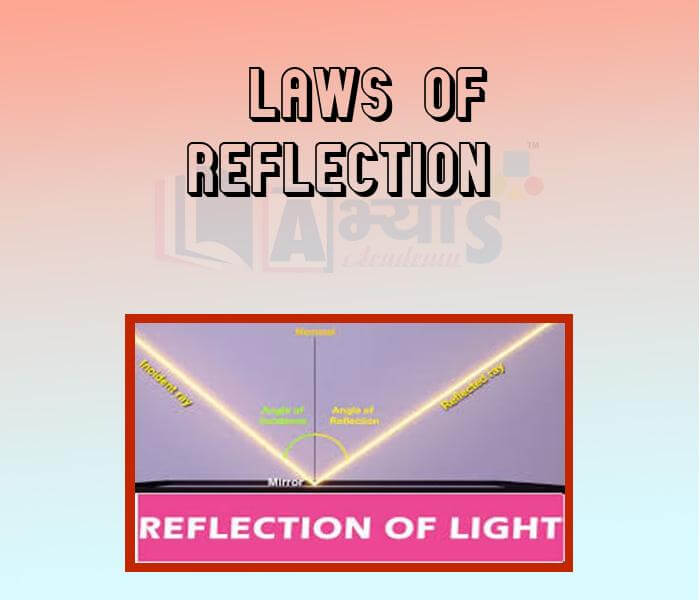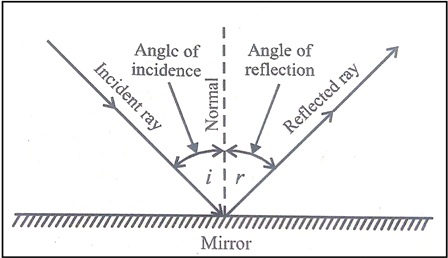Laws of Reflection


Laws of Reflection
It is found that the reflection of light, from a Surface, always take place in a well defined manner according to the rules. We call these two rules as the two laws of reflection. We must, however, first know some terms to understand and explain the two laws of reflection.
(i) The ‘Point of incidence’ and the ‘Normal’: The Point of incidence is that point on the Surface of the mirror where the incident ray falls. A line Perpendicular to the Surface, at the Point of incidence, is known as the ‘Normal.’
(ii) The incident ray and the Reflected ray:The ray of light, coming towards the mirror, is called the incident ray. Similarly, the ray of light, which turns back after ‘reflection’ from the mirror Surface, is called the reflected ray.
(iii) Angle of incidence and Angle of Reflection:The angle between the incident ray and the normal at the point of incidence, is known as the angle of incidence. Similarly, the angle between the normal and the reflected ray, at the point of incidence, is called angle of Reflection
.

(iv) The Plane of incidence and the Plane of Reflection: The Plane, defined by the incident ray and the normal, at the point of incidence, is called the Plane of incidence. Similarly, the plane defined by the reflected ray and the normal, at the point of incidence, is called the plane of reflection.
First Law:
The incident ray, the normal at the point of incidence and the reflected ray, all lie in the same Plane.
Second Law:
The angle of incidence and the angle of reflection are equal to each other.
Illustration: The incident ray makes an angle of 30 degree with the normal. Find the angle of reflection.
Solution: Given, the angle of incidence
According to the laws of reflection
Therefore
Illustration: The incident ray makes an angle of 30 degree with the surface. Find the angle of reflection.
Solution: Given, the ray makes an angle of 30 degree with the surface
And we know the normal makes an angle of with the surface.

From the figure:
angle of incidence
According to the laws of reflection
Therefore
Note: When the ray of light falls normally or perpendicular on the surface of a plane mirror.
Then the angle of incidence is
According to the laws of reflection
So
Hence the ray which is incident normally on a mirror is reflected back along the same path.
The angle of reflection is between the reflected ray and the_______________ | |||
| Right Option : A | |||
| View Explanation | |||
The angle of incidence in a plane mirror as compared to angle of reflection is ___________ | |||
| Right Option : A | |||
| View Explanation | |||
The perpendicular drawn at any point on a mirror is called ______________ | |||
| Right Option : C | |||
| View Explanation | |||
Students / Parents Reviews [20]
My experience with Abhyas academy is very good. I did not think that my every subject coming here will be so strong. The main thing is that the online tests had made me learn here more things.

Hiya Gupta
8thBeing a parent, I saw my daughter improvement in her studies by seeing a good result in all day to day compititive exam TMO, NSO, IEO etc and as well as studies. I have got a fruitful result from my daughter.

Prisha Gupta
8thIt has a great methodology. Students here can get analysis to their test quickly.We can learn easily through PPTs and the testing methods are good. We know that where we have to practice

Barkha Arora
10thAbhyas is good institution and a innovative institute also. It is a good platform of beginners.Due to Abhyas,he has got knoweledge about reasoning and confidence.My son has improved his vocabulary because of Abhyas.Teacher have very friendly atmosphere also.

Manish Kumar
10thMy experience with Abhyas academy is very nice or it can be said wonderful. I have been studying here from seven class. I have been completing my journey of three years. I am tinking that I should join Abhyas Academy in tenth class as I am seeing much improvement in Maths and English

Hridey Preet
9thThe experience was nice. I studied here for three years and saw a tremendous change in myself. I started liking subjects like English and SST which earlier I ran from. Extra knowledge gave me confidence to overcome competitive exams. One of the best institutes for secondary education.

Aman Kumar Shrivastava
10thWe started with lot of hope that Abhyas will help in better understnding of complex topics of highers classes. we are not disappointed with the progress our child has made after attending Abhyas. Though need to mention that we expected a lot more. On a scale of 1-10, we would give may be 7.

Manya
8thAbhyas Methodology is very good. It is based on according to student and each child manages accordingly to its properly. Methodology has improved the abilities of students to shine them in future.

Manish Kumar
10thI have spent a wonderful time in Abhyas academy. It has made my reasoning more apt, English more stronger and Maths an interesting subject for me. It has given me a habbit of self studying

Yatharthi Sharma
10thThird consective year,my ward is in Abhyas with nice experience of admin and transport support.Educational standard of the institute recumbent at satisfactory level. One thing would live to bring in notice that last year study books was distributed after half of the session was over,though study ...

Ayan Ghosh
8thIt was good as the experience because as we had come here we had been improved in a such envirnment created here.Extra is taught which is beneficial for future.

Eshan Arora
8thAbhyas institute is one of the best coaching institute in the vicinity of Ambala cantt.The institute provides good and quality education to the students.The teachers are well experienced and are very helpful in solving the problems. The major advantages of the institute is extra classes for weak...

Shreya Shrivastava
8thMy experience with Abhyas is very good. I have learnt many things here like vedic maths and reasoning also. Teachers here first take our doubts and then there are assignments to verify our weak points.

Shivam Rana
7thOne of the best institutes to develope a child interest in studies.Provides SST and English knowledge also unlike other institutes. Teachers are co operative and friendly online tests andPPT develope practical knowledge also.

Aman Kumar Shrivastava
10thMy experience was very good with Abhyas academy. I am studying here from 6th class and I am satisfied by its results in my life. I improved a lot here ahead of school syllabus.

Ayan Ghosh
8thA marvelous experience with Abhyas. I am glad to share that my ward has achieved more than enough at the Ambala ABHYAS centre. Years have passed on and more and more he has gained. May the centre flourish and develop day by day by the grace of God.

Archit Segal
7thAbhyas academy is great place to learn. I have learnt a lot here they have finished my fear of not answering.It has created a habit of self studying in me.The teachers here are very supportive and helpful. Earlier my maths and science was good but now it has been much better than before.

Barkha Arora
10thMy experience with Abhyas Academy has been very good. When I was not in Abhyas whenever teacher ask questions I could not speak it confidently but when I came in Abhyas, my speaking skills developed and now I am the first one to give the answer of teachers question.

Upmanyu Sharma
7thWhen I have not joined Abhyas Academy, my skills of solving maths problems were not clear. But, after joining it, my skills have been developed and my concepts of science and SST are very well. I also came to know about other subjects such as vedic maths and reasoning.

Sharandeep Singh
7thIn terms of methodology I want to say that institute provides expert guidence and results oriented monitering supplements by requsite study material along with regular tests which help the students to improve their education skills.The techniques of providing education helps the students to asses...
